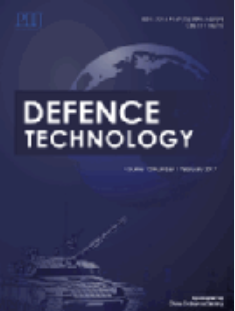聚能射流状态对其与ERA飞板相互作用的影响
IF 5
Q1 ENGINEERING, MULTIDISCIPLINARY
引用次数: 0
摘要
爆炸反应装甲(ERA)在降低聚能射流(SCJ)性能方面非常有效。主要的不稳定机制是SCJ上前后运动板块(MP)的横向运动。因此,很好地理解SCJ/MP的相互作用对于改进武器和装甲系统至关重要。在之前的文章中,我们已经证明了相互作用机制主要受局部碰撞几何形状的影响。因此,在碰撞点帧中,连续的SCJ与MP之间的碰撞角是一个关键参数。当向后移动板块(BMP)逆着SCJ移动时,这个气流角是锐角;当向前移动板块(FMP)沿SCJ移动时,这个气流角是钝角。在前一种情况下,射流只是偏转,这是偏转的区域1。在后一种情况下,这种相互作用开启了碎片和韧带的另一种创造,这就是状态2。碎片是射流的一部分,只有轻微的偏转,而韧带是连接两个连续碎片的弯曲材料桥梁。当拉伸时,射流系统地受到不稳定性的影响,从而扰乱其表面,形成颈部。它们的生长最终导致了射流的破碎。在这篇文章中,我们重点研究了这种射流扰动及其对SCJ/MP相互作用的影响。建立了一个实验装置来实现SCJ与运动板在不同碰撞点、不同隔离距离下的相互作用。该板可以分别在近距离和远距离上与光滑的SCJ或扰动的SCJ相互作用。其中一个主要结果是可视化SCJ/BMP相互作用的机制变化。当碰撞点距离增加时,状态1(偏转)相互作用转变为韧带状态相互作用(类似于FMP状态2)。提出这种变化可以归因于射流表面扰动幅度的增加。这一现象在γSPH模拟中得到了很好的体现。最后,我们采用实验和数值方法,对扰动面射流与运动板块相互作用过程中出现的不同现象进行了新的详细分析。相互作用状态的变化与射流局部几何变化有关。BMP与光滑表面或扰动表面的相互作用在几何上是不同的,从而产生不同的局部流动和相互作用机制。然而,也有一些用表面已被扰动过的等速射流进行的模拟。这些模拟强调了干扰波长λ和振幅A对相互作用机制的影响。SCJ的表面扰动与它的拉伸有关,对它与运动板块的相互作用有重大影响。本文章由计算机程序翻译,如有差异,请以英文原文为准。
Influence of shaped charge jet state on its interaction with ERA flying plate
The Explosive Reactive Armors (ERA) are really efficient at reducing Shaped Charge Jet (SCJ) performance. The main destabilizing mechanism is the transverse movement of the front and rear moving plates (MP) on the SCJ. Therefore, a good understanding of the interaction SCJ/MP is essential for improving both weapon and armor systems. In a previous article, we have shown that interaction regimes are mainly influenced by the local collision geometry. Thus, in the collision point frame, the angle of collision between the continuous SCJ and the MP is a key parameter. This flow angle is acute for the Backward Moving plate (BMP) moving against the SCJ and obtuse for the Forward Moving Plate (FMP) moving alongside it. In the former, the jet is simply deflected, which is the regime 1 of deflection. In the latter, the interaction turns on an alternative creation of fragment and ligament, which is the regime 2. Fragments are parts of the jet that are only slightly deflected while ligaments are the curved material bridges that connect two consecutive fragments.
When stretching, the jet is systematically subject to instabilities that disturb its surface, creating necks along it. Their growth finally leads to the jet fragmentation. In this article, we focus on this jet disturbance and its consequences on the SCJ/MP interaction.
An experimental set-up was built to implement the interaction between a SCJ and a moving plate for different collision points, at different stand-off distances. The plate can interact with a smooth SCJ or a disturbed SCJ at a close and a far stand-off distance, respectively.
One of the main results is the visualization of a regime change in SCJ/BMP interaction. A regime 1 (deflection) interaction changes into a ligament regime interaction (similar to a FMP regime 2) when the collision point stand-off is increased. It is proposed that this change can be attributed as the increase of the amplitude of the jet surface disturbances. This phenomenon is well captured by the simulations. Finally, using both experimental and numerical approaches, we propose a new detailed analysis of the different phenomena occurring during the interaction between a disturbed-surface jet and a moving plate. Interaction regime changes are linked to jet local geometry changes. The interactions of a BMP with a smooth SCJ or with a disturbed surface SCJ are geometrically not the same and, thus, generate different local flows and interaction mechanisms.
However, some other simulations have been carried out with constant velocity jet whose surface has been previously disturbed. These simulations underline the influence of both disturbance wavelength and amplitude on the interaction regimes.
Surface disturbances of the SCJ, linked to its stretching, have a major influence on its interaction with a moving plate.
求助全文
通过发布文献求助,成功后即可免费获取论文全文。
去求助
来源期刊

Defence Technology(防务技术)
Mechanical Engineering, Control and Systems Engineering, Industrial and Manufacturing Engineering
CiteScore
8.70
自引率
0.00%
发文量
728
审稿时长
25 days
期刊介绍:
Defence Technology, a peer reviewed journal, is published monthly and aims to become the best international academic exchange platform for the research related to defence technology. It publishes original research papers having direct bearing on defence, with a balanced coverage on analytical, experimental, numerical simulation and applied investigations. It covers various disciplines of science, technology and engineering.
 求助内容:
求助内容: 应助结果提醒方式:
应助结果提醒方式:


